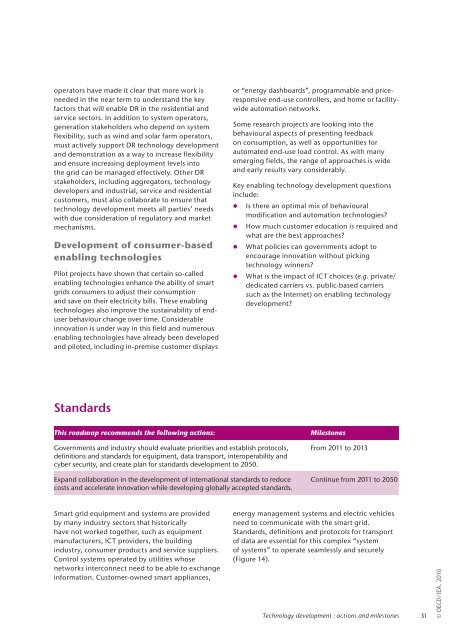Technology development: actions and milestonesThis roadmap recommends the following actions:Build up commercial-scale demonstrations that operate across systemboundaries of generation, transmission, distribution and end-use andthat incorporate appropriate business models addressing key issuesincluding cost, security and sustainability.Enable increased levels of demand response for customers fromindustrial, service and residential sectors, co-ordinating collaborationand responsibilities among electricity system stakeholders.Develop and demonstrate consumer-based enabling technologiesincluding behavioural, policy and technical aspects.MilestonesConcentrated effort from 2011 to 2025Completed by 20202011 to 2020Development anddemonstrationThe need for commercial-scaledemonstrationThe existing smart grid technology landscape ishighly diverse. Some technology areas exhibit highlevels of maturity while others are still developingand not ready for deployment. Although continuedinvestments in research and development areneeded, it is even more important to increaseinvestments in demonstration projects thatcapture real-world data, integrated with regulatoryand business model structures, and to workacross segmented system boundaries – especiallyinteracting with end-use customers. While thisis happening currently as a result of stimulusfunding (Table 5), it is vital that it continue toexpand. Only through large-scale demonstrations– allowing for shared learning, reduction ofrisks and dissemination of best practices – canthe deployment of smart grids be accelerated.Current levels of political ambition appear to besufficient, but high quality analysis and positivedemonstration outcomes must be highlighted tosustain these levels.Demand response enabledby smart gridsDemand response (DR) is one of the keyapproaches enabled by smart grids. Changes inthe generation sector will include the increaseddeployment of variable generation to levels over20% of overall demand in many regions, withsome regions significantly surpassing this level.Increased consumption of electricity from bothexisting and new loads will continue to placestress on the electricity system and increasepeak demand. Variable generation resourcesand peak demand can be managed by a rangeof mechanisms – DR being one – where morepotential is ready to be exploited.Load management, in the form of direct loadcontrol, peak shaving, peak shifting and variousvoluntary load-management programmes, hasbeen implemented since the early 1980s. Withdemand response, the system operator will be ableto monitor and manage demand; the electricitygrid will thus move from load-following to loadshapingstrategies in which demand-side resourcesare managed to meet the available generation andthe grid’s power delivery capabilities at any giventime (Ipakchi and Albuyeh, 2009).Demand response cuts across several technologyareas highlighted earlier, including customersidesystems, advanced metering infrastructure,distribution management and automation, andsometimes stretching from generation to end-use.Additionally, there are three main customer groupswith different DR profiles: industrial, service andresidential. A relatively few industrial customerswith large electricity demands could have asignificant impact on the electricity system; maturetechnologies and market approaches exist forapplications in this end-use sector. A large numberof residential consumers would be needed to havea similar effect and the technology, behaviouraland market models are much less mature. Theservice sector falls somewhere in the middle.Demand response can significantly reduce peakdemand and – in the longer term – provide theflexibility needed, both in volumetric terms and inspeed of response, to support variable generationtechnologies. Given current technological andmarket design maturity levels, however, system30 Technology <strong>Roadmap</strong>s <strong>Smart</strong> grids© OECD/IEA, 2010
operators have made it clear that more work isneeded in the near term to understand the keyfactors that will enable DR in the residential andservice sectors. In addition to system operators,generation stakeholders who depend on systemflexibility, such as wind and solar farm operators,must actively support DR technology developmentand demonstration as a way to increase flexibilityand ensure increasing deployment levels intothe grid can be managed effectively. Other DRstakeholders, including aggregators, technologydevelopers and industrial, service and residentialcustomers, must also collaborate to ensure thattechnology development meets all parties’ needswith due consideration of regulatory and marketmechanisms.Development of consumer-basedenabling technologiesPilot projects have shown that certain so-calledenabling technologies enhance the ability of smartgrids consumers to adjust their consumptionand save on their electricity bills. These enablingtechnologies also improve the sustainability of enduserbehaviour change over time. Considerableinnovation is under way in this field and numerousenabling technologies have already been developedand piloted, including in-premise customer displaysor “energy dashboards”, programmable and priceresponsiveend-use controllers, and home or facilitywideautomation networks.Some research projects are looking into thebehavioural aspects of presenting feedbackon consumption, as well as opportunities forautomated end-use load control. As with manyemerging fields, the range of approaches is wideand early results vary considerably.Key enabling technology development questionsinclude:zzzzzzzzIs there an optimal mix of behaviouralmodification and automation technologies?How much customer education is required andwhat are the best approaches?What policies can governments adopt toencourage innovation without pickingtechnology winners?What is the impact of ICT choices (e.g. private/dedicated carriers vs. public-based carrierssuch as the Internet) on enabling technologydevelopment?StandardsThis roadmap recommends the following actions:Governments and industry should evaluate priorities and establish protocols,definitions and standards for equipment, data transport, interoperability andcyber security, and create plan for standards development to 2050.Expand collaboration in the development of international standards to reducecosts and accelerate innovation while developing globally accepted standards.MilestonesFrom 2011 to 2013Continue from 2011 to 2050<strong>Smart</strong> grid equipment and systems are providedby many industry sectors that historicallyhave not worked together, such as equipmentmanufacturers, ICT providers, the buildingindustry, consumer products and service suppliers.Control systems operated by utilities whosenetworks interconnect need to be able to exchangeinformation. Customer-owned smart appliances,energy management systems and electric vehiclesneed to communicate with the smart grid.Standards, definitions and protocols for transportof data are essential for this complex “systemof systems” to operate seamlessly and securely(Figure 14).Technology development : actions and milestones31© OECD/IEA, 2010
















